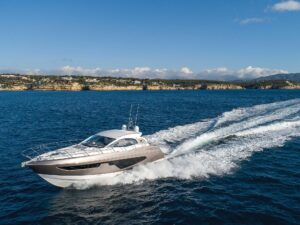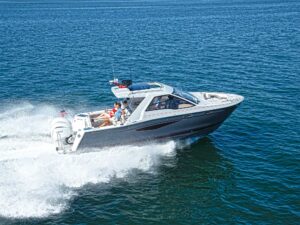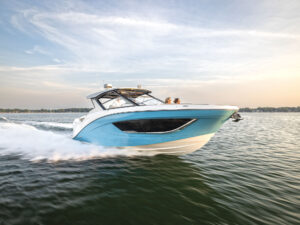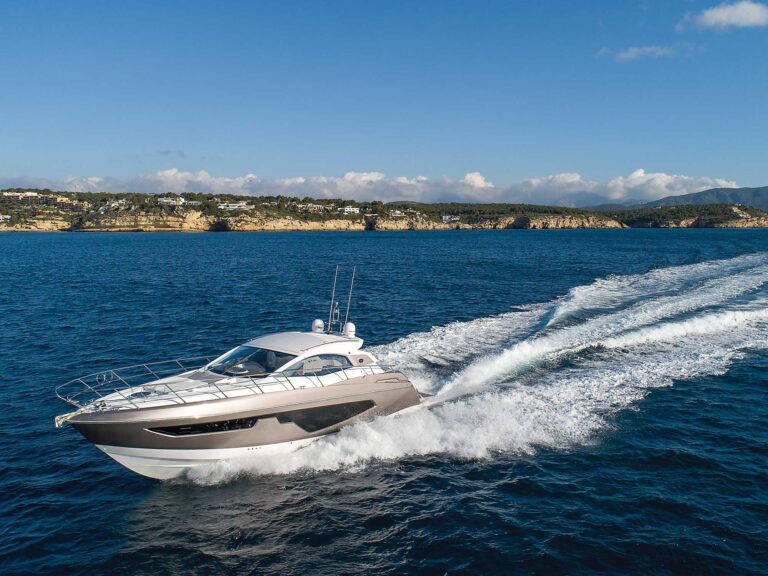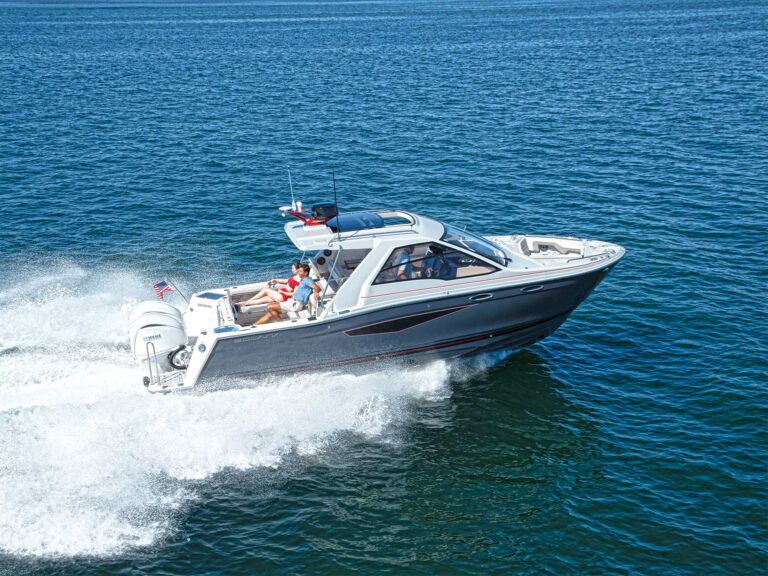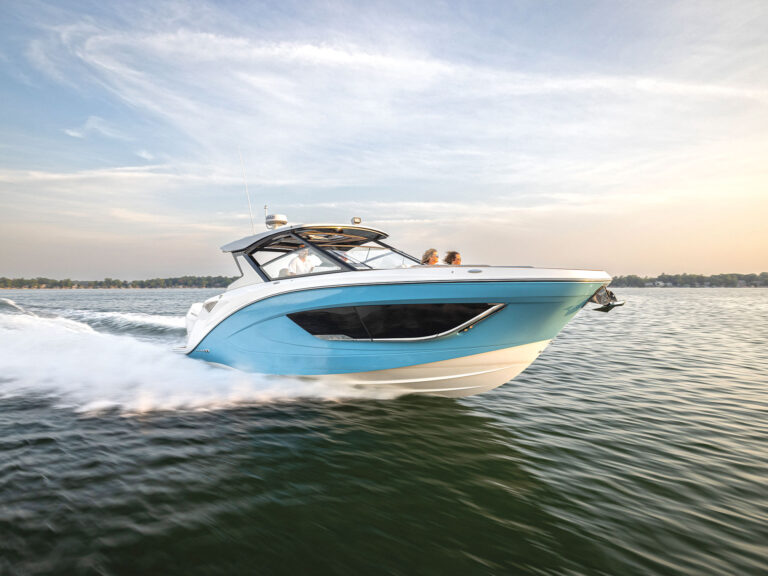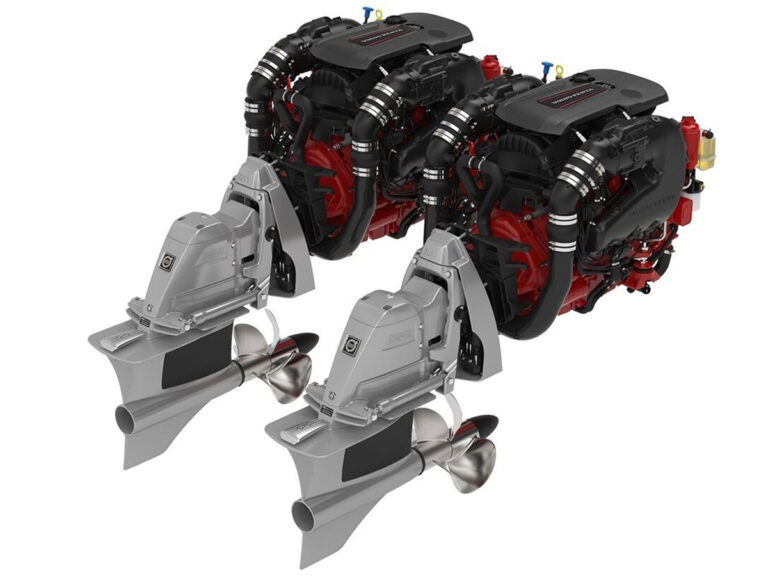I kick the spurs into 150 horses, then whip the other 150 into reverse. The transom shoves a three-foot wave out of the way and slides sideways into the trough as a barrel-chested blue marlin fractures the ocean’s surface, spitting froth and fury just 10′ off the gunwale. The angler pumps and cranks and I can hear the fish’s sword-like weapon slicing air as it shakes its head, trying to fend off our attack. Boating Associate Editor Dan Long reaches out with a gloved hand, grabs the leader, and holds tight until it pops. It’s an official release. We all sit down and breathe. Six hands are shaking, six minds are calculating. Dan guesses it might have gone 500 pounds. Maybe it was-all I can say for sure is that the fish was too damn big for me to accurately estimate its weight. No doubt it was the biggest blue marlin caught on a Boating project boat in 2005, and it was one of nine marlin caught from this year’s test bed: a Glacier Bay 2665 Canyon Runner powered by twin 150-hp Yamaha F150 outboards. You know all those rumors you’ve heard about powercats creating too much whitewater to be effective billfishing boats? This boat proves that’s a load of crap!
GOOD INSTINCT. The 2665 Canyon Runner under our command made 16 bluewater runs this year, plus a dozen or so bay and inshore trips. We put more than 260 hours of running time on it. We trolled the canyons, bailed weedlines, fished wrecks, and drifted channels. This boat is a kickass fishing machine. Check the port side integrated fishbox, for starters. It’s large enough to hold a giant-yes, giant-bluefin tuna. One day we loaded it with four 50-to-70-pound yellowfin tuna, 22 mahi-mahi between 5 and 10 pounds, a handful of triggerfish, 120 pounds of ice, and a 48-quart cooler full of food and drinks-it was about half full. I dare you to find any 26′ fishboat with a larger fishbox. Plus, it’s well insulated and the hatch is supported by a gas-assist strut. World Cat takes a different approach on its competing 250 SF ($91,871 with twin 150-hp Yamaha F150s), putting its fishbox in the transom. It’s around half the size of the 2665 Canyon Runner’s, which is still good for a boat of this size, but it’s not as well insulated.
The 2665 Canyon Runner’s starboard side in-deck box is rigged with rodracks and has a locking hatch. I found it poor for rod stowage, though. These boxes sit lower than the waterline and pump out with bilge pumps, so there’s always some moisture in them. When I left rods down there, the cork and foam grips became mold farms.
The T-top holds four rocket launchers and the leaning post has another four, although they’re tight and fitting International 30s into them all at the same time takes some creative jiggling. Still, between these and the four gunwale holders, a trolling spread of eight lines is easy to deploy. That leaning post also houses a 32-gallon lighted livewell with viewing port, rig holders, and a cutting board. There’s also a swing-out stowage drawer and slots for three medium-size tackle stowage trays on each side. Four larger trays fit in the transom, under another cutting board with rig, knife, and pliers holders. Racks under the gunwales hold an additional four rods or gaffs and mops. Gunwale bolsters line the sides and there’s a freshwater shower at the transom. The raw-water wash is potent and comes rigged with a self-coiling hose that hides behind a pie plate in the side of the console. That puts it far enough forward that you can wash down both the bow and stern areas of the boat when the fish blood starts flying. Our test boat also had a “buggy seat” crow’s nest on the top ($815), which came in handy as we trolled around looking for flotsam, lobster buoys, and the like. Added bonus: It’s comfier than you’d think, and several times my crew rode on top for 40-mile-plus cruises.
Our project boat had one other unusual optional feature, a folding dodger top on the bow. It stowed completely out of the way, and when deployed, it turned the large padded bow deck into a mini-cuddy. For overnighting at the canyons, it was invaluable. Even when the dodger was folded down, the bow deck was one of the comfiest spots on the boat; it’s large enough for a couple to lounge, and surprisingly, several people napped in the bow even as we cruised through three-foot seas.
CAT ATTACK. Hold on there, partner-you say it’s impossible to nap in the bow while cruising at 30 mph through three-footers? Normally I’d agree. But this is no normal boat. The 2665 Canyon Runner’s twin semi-displacement hulls provide an exceedingly smooth ride. In fact, foot for foot, I believe this to be the smoothest running boat I’ve ever tested long-term.
We ran through all types of seas over the course of the summer and it pounded twice. I don’t mean for two rides, I mean on two waves. In fact, we canceled a trip when the seas were running a nasty six feet and, later in the day, popped through the inlet just to see how the boat would handle it. Mushing over the moguls at 24 mph, I regretted having canceled in the first place. Don’t forget-Boating’s accelerometer test of this boat’s predecessor, the 260 Canyon Runner, against a 26′ monohull with a 24-degree deep-V hull (“Mr. Smoothie,” December 2004) proved that the impacts were reduced by over 25 percent on the cat hull and decelerations were reduced 3.5 times, as compared to the mono.
Waiting for the other shoe to drop? Of course there’s a downside to running such a rig. In fact, I identified two worthy of note. The first is the snap roll. Perhaps half a dozen times through the season we were hit on the beam by large boat wakes. These evenly spaced waves caused one hull to drop off into the trough while the other went up on a crest, violently rocking the boat. Worse than on a V-hull? You bet. Slight course alterations take care of the problem, but the captain must be on the lookout for beam-to boat wakes. The second downside-it sneezes. In certain conditions the 2665 Canyon Runner will blow a puff of mist out of the front of the tunnel. No big deal, but on occasion it meant we were damp for the entire ride. For this reason, I think the boat would be enhanced greatly if a large windscreen were installed along with a windshield wiper.
One thing that was always dry on this boat was our butts. Someone please give the folks who work in Glacier Bay’s upholstery shop a big pat on the back. The seat cushions and gunwale bolsters never absorbed water or leaked, common boat cushion gripes. The cushions were comfy and rugged enough to make it through the entire season without tearing or puncturing. The bi-fold design of the bow cushion made it easy to fold in half when accessing stowage and, when folded flat, turned the entire bowdeck into a cushy lounge. And when this cushion did double duty as a berth, it didn’t make my back sore.
Damn-there’s so much more you need to know about this boat and we’re out of space. So look carefully at the Boating certified performance numbers and you’ll understand just how fast and efficient this boat is. Know that the only items on the boat that broke all summer were a snap on the canvas dodger and the gas-assist strut on the fishbox. Most important, know that this project boat will be missed dearly by all of us-except the marlin.
SECOND OPINION. This is one awesome riding boat, though sneezing did make it damp at times. Night fishing was my favorite, however. It was a cut above the norm, because the fluorescent light mounted in the underside of the T-top pipework and LED courtesy lights under the gunwales kept the entire deck lit all night, without wearing down the battery. When we needed extra visibility, the spreader lights on the top blasted the cockpit like the midday sun.
Stowage was another high point, thanks to the bowdeck and console compartments. And accessing the props and outboards was easier than on any similar boat because of the large aft platform. That platform also made bay swimming and clamming a pleasure by letting us easily get in and out of the boat. Divers will love it, too.
I’d like to see some larger grabrails aft of the helm, because that’s where passengers often end up standing on long cruises. And if the rodbox under the deck could be made watertight and kept dry, it would improve stowage. Overall, though, I absolutely loved this boat. We fished it hard all season, with virtually nothing breaking or malfunctioning. -Rocky Calia
THE HIGHS: The smoothest riding 26′ project boat ever with the biggest fishbox ever. List of broken items at the year’s end was almost nonexistent-construction is excellent. Buggy seat and bow dodger enhance comfort and fishability and aren’t found on competing boats.
THE LOWS: Leaning post rocket launchers aren’t far enough apart. Sneeze factor can be annoying at times. Snap roll can be annoying at other times. Rodbox is too moist for long-term rod stowage.

